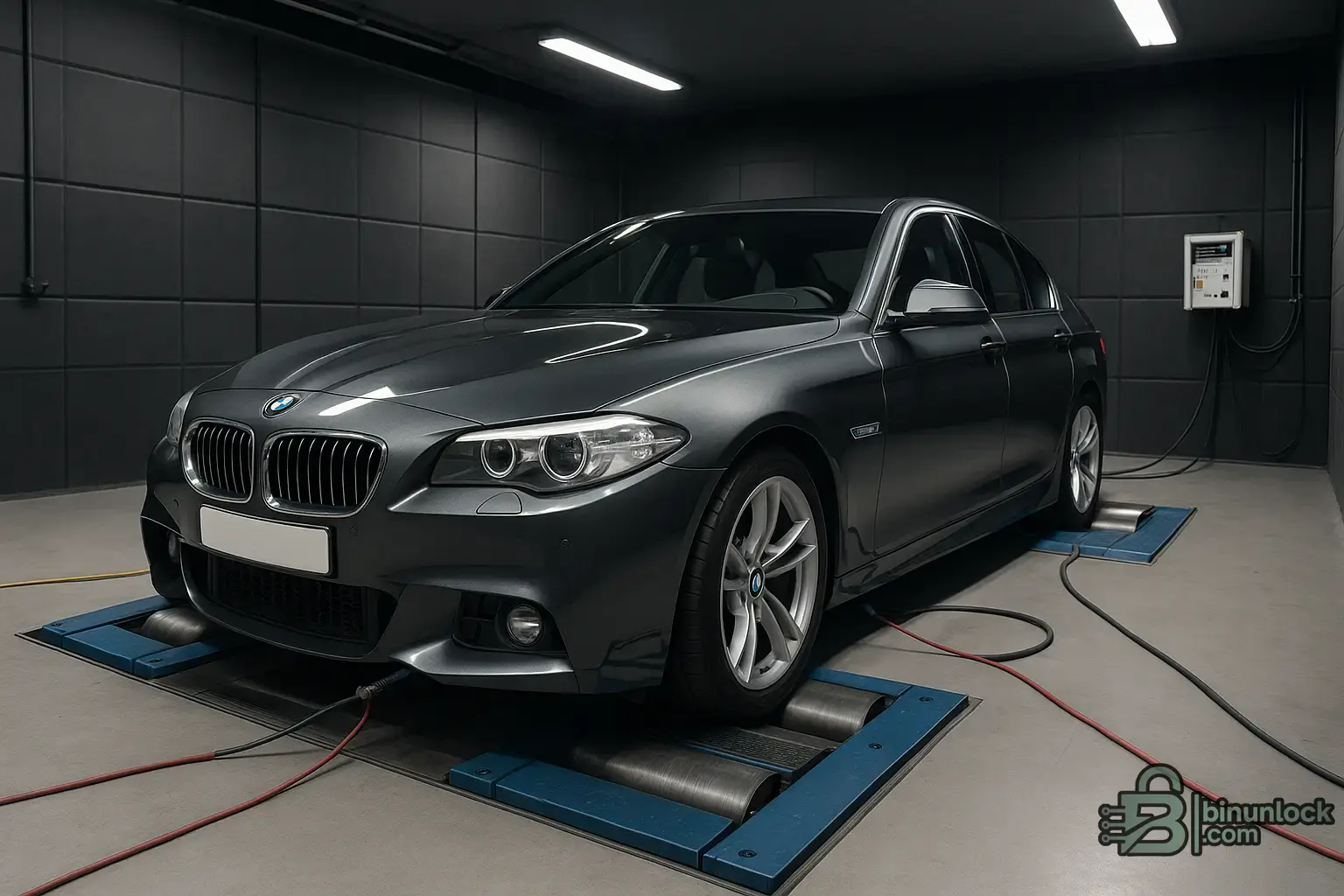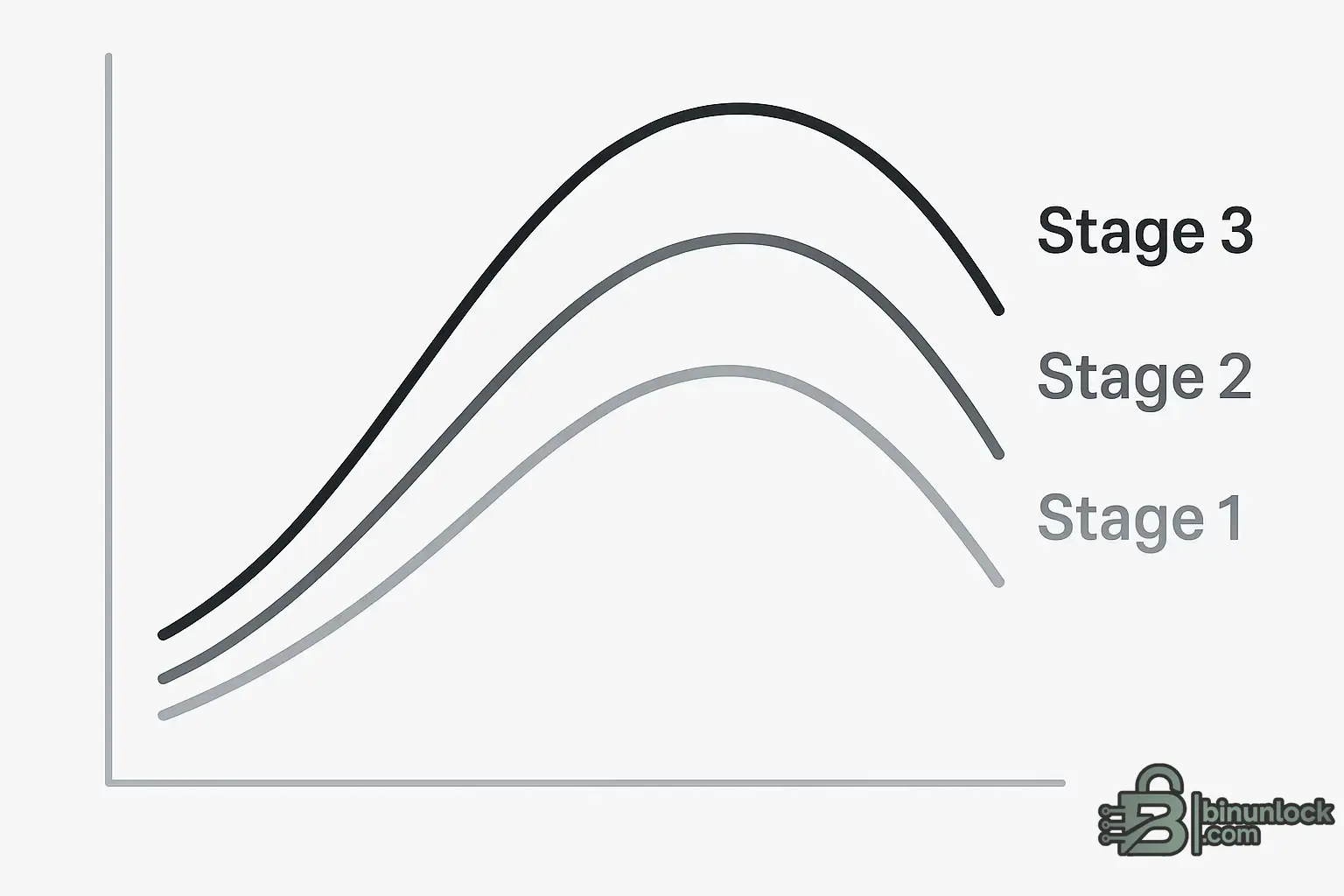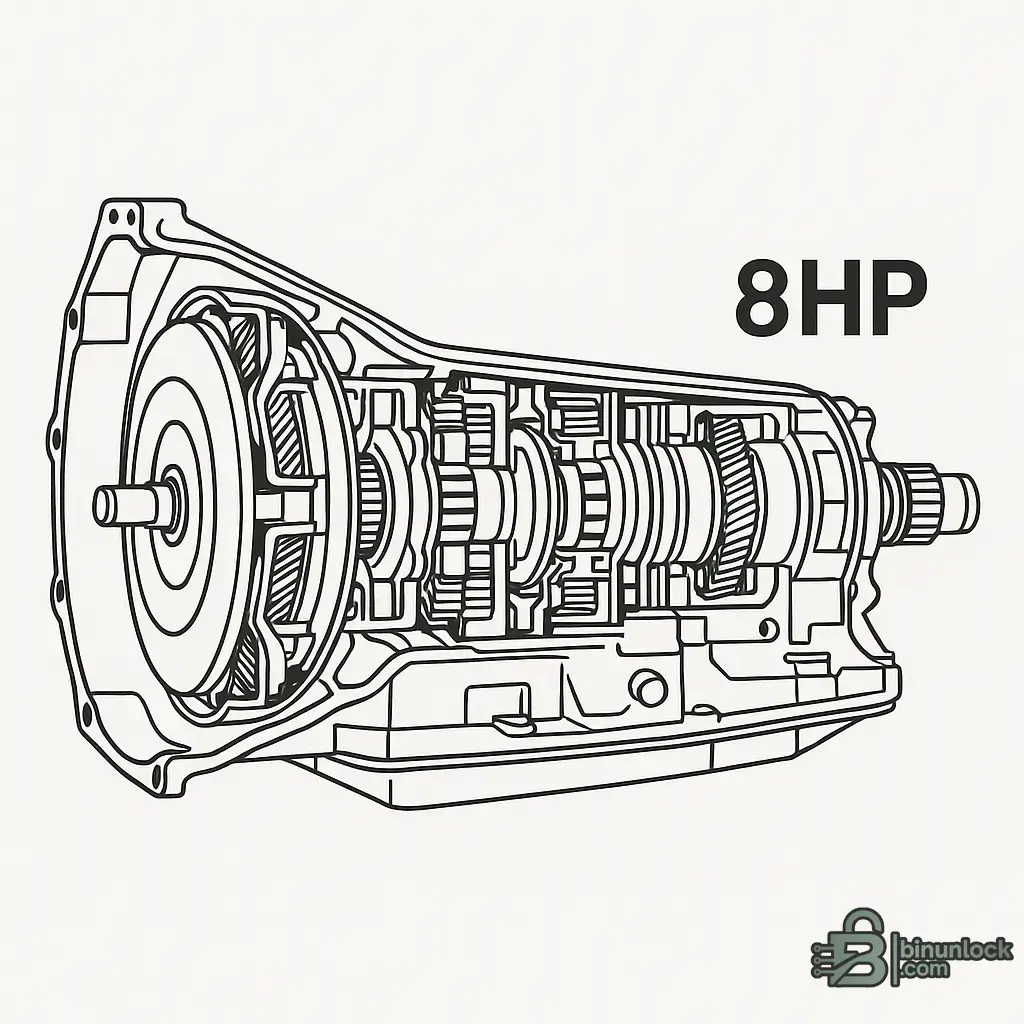Introduction
Tuning the BMW 5 Series (F10 sedan, F11 touring, F07 Gran Turismo, model years 2010–2017) requires knowing which engine and ECU the car has and how to access it (OBD, bench, or boot). This article is a practical, no-hype overview for people who actually flash and edit files. It covers the following- Main engines used in the F10/F11/F07 platform.
- Which Bosch ECUs they use.
- How they are usually read or written.
- Typical tools.
- Stage logic Stage 1, Stage 2, Stage 3.
- Safe boost, torque, fueling ideas.
- Transmission tuning ZF 6HP, ZF 8HP, M-DCT.
- What to log to verify the tune.
- How to avoid bricking and why full backups matter.

Engine Lineup and ECU Overview
BMW used multiple petrol and diesel engines in the 2010–2017 5 Series. Each engine has its own DME (petrol) or DDE (diesel). Below is a cleaned up list without external links.Petrol engines
- N20/N26 – 2.0L turbo I4 (520i/528i). ECU — Bosch MEVD17.2.x (MED17 family).
- N55 – 3.0L turbo I6 (535i). ECU — Bosch MEVD17.2.x.
- N63 – 4.4L twin-turbo V8 (550i). ECU — Bosch MEVD17, two DMEs (bank to bank).
- S63 – 4.4L twin-turbo V8 (M5). ECU — Bosch MEVD17, two DMEs.
- B48 – 2.0L turbo I4 (late or rare on F chassis). ECU — Bosch MEVD17 or MG1/MD1 depending on year.
- B58 – 3.0L turbo I6 (mainly G series but relevant for similar tuning logic). ECU — Bosch MG1/MDG1.
Diesel engines
- N47 – 2.0L turbo I4 (518d/520d/early 525d). ECU — Bosch EDC17C41 (DDE7).
- N57 – 3.0L turbo I6 (530d/535d) and tri-turbo N57S (M550d). ECU — Bosch EDC17CP45 or close variants.
- B47 – 2.0L turbo I4 (late cars, replaces N47). ECU — Bosch EDC17C56 or later MD1/DDE8.
Table — F10/F11/F07 Engines vs ECU vs Access
| Engine / Model | Bosch ECU | Read/Write Access (typical) | Compatible Tools (examples) |
|---|---|---|---|
| N20/N26 – 2.0L petrol | MEVD17.2.x | First time via bench or boot to unlock OBD, afterwards OBD flash | KESS/KTAG, Autotuner, FLEX/Magic (bench or boot), then MHD or Bootmod3 via OBD |
| N55 – 3.0L petrol | MEVD17.2.x | Later software requires bench unlock, earlier sometimes OBD directly | KESS/KTAG, Autotuner (bench), then MHD or Bootmod3 (OBD) |
| N63 / S63 – 4.4L V8 petrol | MEVD17 (2 DMEs) | Bench or boot per DME, both ECUs must be flashed | KTAG/Autotuner bench, then OBD solutions for unlocked DMEs |
| N47 – 2.0L diesel | EDC17C41 | Older units allow OBD, many require bench or boot with Tricore password | KESS3/Autotuner (OBD if supported), KTAG/PCMFlash (bench or boot) |
| N57 – 3.0L diesel | EDC17CP45 | Very often bench or boot first, OBD after patch | KTAG/Autotuner bench, some OBD flashers after unlock |
| B47 – 2.0L diesel | EDC17C56 or MD1/DDE8 | Newer software needs bench unlock, earlier may allow OBD | Modern bench tools, then OBD flashers once unlocked |
| B48 – 2.0L petrol | MG1/MD1 | Bench unlock required, then OBD | Tools with MG1/MD1 support and later OBD apps |
| B58 – 3.0L petrol | MG1/MDG1 | Bench unlock required, then OBD | Bootmod3, MHD (after unlock), bench tools |
Note “bench unlock” = first connection on the bench or harness to remove OBD flash lock. After that, the car can be flashed via OBD as many times as needed.
ECU Types and Tuning Methods
Bosch MEVD17 (petrol)- Tricore based with OBD programming lock on later software.
- Typical workflow for F10/F11 — remove ECU, connect on bench or boot, do full read and unlock, write back.
- After unlock the user can use OBD flashers (MHD or Bootmod3 on N55/N20/S63/N63).
- Always use a stable power supply while writing.
Bosch EDC17 (diesel)
- Also Tricore based with anti tuning.
- A full file is usually read on bench or boot, or via virtual read based on ID.
- Write can sometimes be done via OBD if the tool supports RSA defeat or if the ECU is pre patched.
- Opening the ECU for boot mode is normal on these F series diesels.
Newer MG1 / MD1
- Stronger encryption.
- Bench unlock is mandatory.
- After unlock you can do normal OBD flashing.
OBD vs Bench vs Boot (summary)
- OBD — fastest and safest for the end user, but only after the ECU is unlocked.
- Bench — safest first access and allows a full backup and checksum verified write.
- Boot — invasive bench variant (ECU open, boot pin to GND) used for recovery or when the normal protocol fails.

Tuning Stages
Stage 1- Stock hardware.
- Moderate boost increase (petrol adds about plus three to five psi over stock midrange, diesel adds about ten to fifteen percent more air and fuel).
- AFR and lambda enriched at WOT for turbo petrol — target about 0.80–0.82 lambda which is roughly 12.0 to 1 AFR.
- Typical gains — N55 535i goes from about 306 hp to about 340–360 hp with torque plus 80 Nm. The 520d N47 adds about 30–40 hp and about 70–90 Nm.
- All emissions equipment stays active.
Stage 2
- Assumes basic hardware — high flow or catless downpipe, better intercooler, freer exhaust, intake optional.
- Allows higher boost, for example 16–18 psi on N55.
- Requires proper WGDC tables to avoid overboost spikes.
- On petrol — richer WOT mixture around 12.0 to 1 to keep the charge cool.
- On diesel — often combined with DPF or EGR off for off road use to control EGT and soot.
- Torque rises enough that the ZF TCU may hit a torque limit, so a transmission tune is recommended.
Stage 3 / custom / big turbo
- Bigger or hybrid turbos, upgraded HPFP or injectors, sometimes port injection.
- The torque curve is shaped to protect rods and the 8HP gearbox, with no giant low RPM spike.
- Safe ceiling examples (rough and dependent on condition and fuel).
- N20 — about 260–280 hp on the stock turbo before an upgrade is needed.
- N55 — about 430–450 hp and about 600 Nm on the stock turbo with good fuel and cooling.
- N63/S63 — plus 100 hp on stock turbos is normal, 600 plus hp on S63TU is realistic with downpipes and good cooling.
- N57 — torque is frequently capped at about 700–750 Nm to protect the ZF 8HP.

Transmission Tuning (ZF6HP, ZF8HP, M-DCT)
Most F10/F11 cars use a ZF 8HP with different torque classes — 8HP45, 8HP50, 8HP70. Some earlier or lower power cars can have 6HP. The F10 M5 uses a 7 speed M-DCT.Why tune the transmission
- The TCU has torque limits. If the engine ECU requests more torque than allowed, the TCU or ECU can cut power or go to failsafe.
- Raising torque ceilings lets the engine deliver the tuned torque.
- A TCU tune can raise line pressure which gives stronger clutch clamping and no slip on high torque diesel or petrol setups.
- Shift logic can be made faster and more manual with true M mode and no forced upshift at redline.
Practical rules
- Stage 1 petrol with a modest torque gain — the stock TCU is usually OK.
- Stage 2 petrol or any strong diesel with plus twenty five to thirty percent torque — a TCU tune is strongly recommended.
- M-DCT on the M5 — increase clutch pressure when pushing above about 800 Nm.

Key Logging Parameters
After flashing, always log. One full throttle third or fourth gear pull tells a lot. Watch for the following- AFR / Lambda (petrol) — at WOT hold around 11.8–12.2 to 1 (0.80–0.82 λ). Leaner than 12.5 to 1 at high boost is a bad sign.
- Boost (target vs actual) — it should track with at most 1–2 psi overshoot. If WGDC is at 100% and boost is low, suspect the turbo or a leak.
- Ignition timing and knock corrections — an occasional minus one to minus two degrees on a single cylinder is OK. Repeated minus three degrees across cylinders means the tune is too aggressive.
- Fuel rail pressure — N55 and similar should hold their target around 140–200 bar depending on load. If pressure drops, scale back or upgrade fuel.
- Fuel trims — WOT trims should not be pegged. Large LTFT points to a mechanical issue such as a leak or sensor and not the tune.
- IAT — above about 60°C the ECU will start to pull. Stock intercoolers heat soak fast, so Stage 2 really wants a better intercooler.
- EGT (especially diesel) — sustained very high EGT means you should reduce fuel or improve airflow.
Backing Up, Checksums, and Bricking Prevention
Golden rules- Always do a full backup before the first write (flash and, if possible, EEPROM).
- Use a flasher that auto corrects checksums. Do not disable checksum correction.
- Use stable power for the car and for the laptop.
- Do not touch anything during the write (no doors, no ignition off, no cable wiggle).
- Write only files that match the ECU software version and the hardware you read.
- If an OBD write fails and the ECU no longer responds, recover on bench or boot.
- Keep multiple versions of your files with clear names (stock, Stage 1 98 RON, Stage 2 DP, etc.).
If the boot sector gets corrupted during a write, recovery might require professional BDM or bench. Proper tools and stable voltage make that scenario rare.
Case Studies
Case 1 — Daily Driver Stage 1 (535i N55)- Car — 2012 535i, stock hardware.
- DME bench unlocked once, OBD tune afterwards.
- Boost from about 0.7 bar stock to about 1.0 bar midrange, then taper to 0.8 bar.
- WOT AFR about 12.2 to 1, timing conservative.
- Result — about 340 hp and about 480 Nm. No DTCs, emissions intact.
- Owner advised to change plugs more often.
Case 2 — Economy and Torque Tune (520d N47)
- Car — 2014 520d, 8HP auto, stock hardware.
- Mild torque increase in 1500–2500 rpm (about plus fifteen percent).
- Slight boost increase, injection optimised for a cleaner burn.
- DPF and EGR kept working, calibrated to avoid soot under load.
- Result — better low end, fewer downshifts, five to ten percent better highway fuel consumption.
Case 3 — High Power S63 (F10 M5)
- Car — 2015 M5 Competition, catless downpipes and better cooling.
- Both DMEs bench unlocked and flashed together.
- Boost raised to about 1.5 bar in the midrange, taper at high rpm.
- WOT lambda richened to about 0.80 for track use.
- Torque targets raised to about 900 Nm with the curve shaped to avoid a huge low rpm spike.
- M-DCT flashed to raise clutch pressure and speed up shifts.
- Result — about 690–700 hp on pump 98 RON, repeatable on track thanks to the richer mix and cooling.
Conclusion
- Identify the exact engine and ECU first — that defines how you will read and write it.
- Assume F series DMEs and DDEs are OBD locked and plan a bench or boot unlock.
- Match the tune stage to the hardware actually on the car. Do not run Stage 2 on a stock downpipe or cooling.
- Log every serious change. If AFR, boost, timing or fuel pressure do not look right, fix the map before doing more pulls.
- If torque increase is large, tune the transmission so it will not be the bottleneck.
- Protect yourself from bricks with good tools, stable power, correct files and no interruptions.